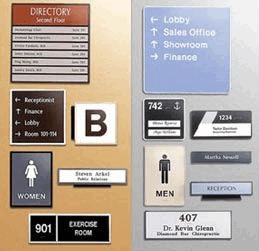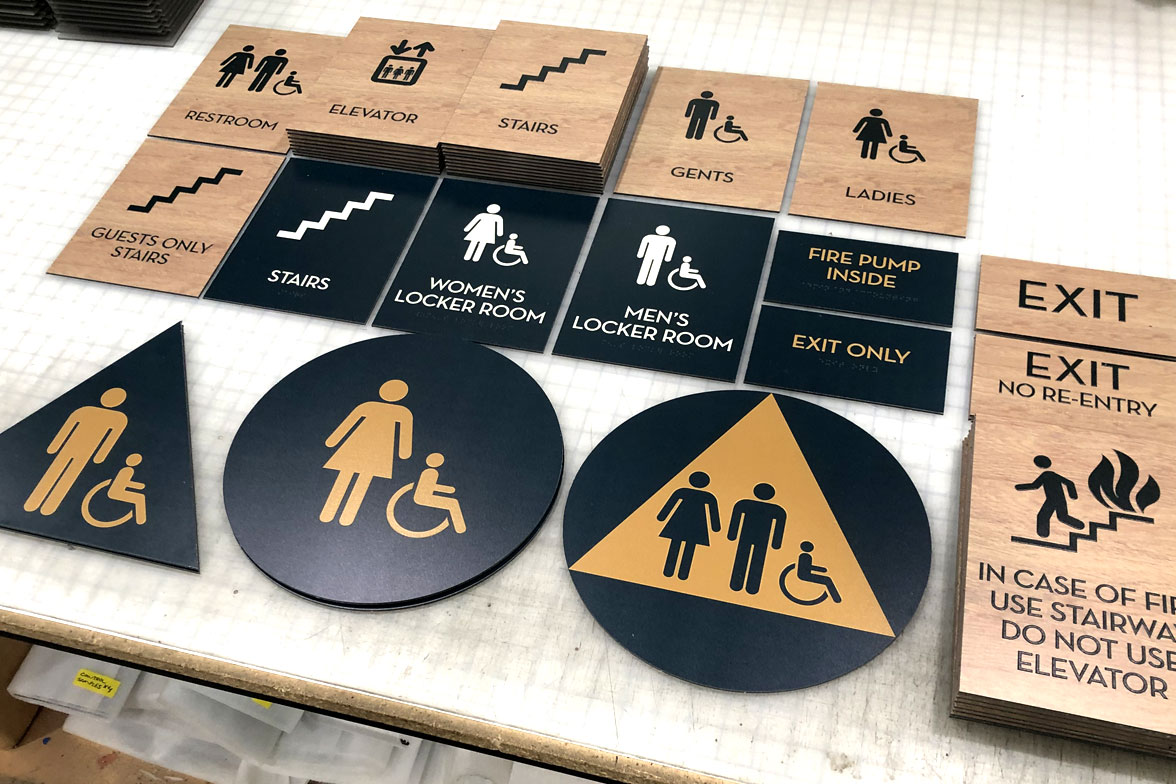Check out the Importance of ADA Signs in Public Spaces
Check out the Importance of ADA Signs in Public Spaces
Blog Article
Checking Out the Secret Attributes of ADA Signs for Boosted Ease Of Access
In the world of access, ADA indicators function as silent yet powerful allies, making certain that areas are navigable and comprehensive for people with handicaps. By incorporating Braille and tactile aspects, these signs damage barriers for the aesthetically damaged, while high-contrast color pattern and clear fonts cater to diverse aesthetic demands. Their calculated positioning is not arbitrary yet rather a computed effort to facilitate seamless navigation. Past these features lies a deeper narrative about the development of inclusivity and the continuous dedication to creating fair spaces. What a lot more could these indications represent in our quest of global availability?
Relevance of ADA Conformity
Making certain compliance with the Americans with Disabilities Act (ADA) is critical for promoting inclusivity and equal accessibility in public rooms and work environments. The ADA, passed in 1990, mandates that all public centers, employers, and transportation solutions suit people with specials needs, guaranteeing they appreciate the same rights and possibilities as others. Compliance with ADA requirements not only meets legal responsibilities yet also enhances an organization's reputation by demonstrating its commitment to variety and inclusivity.
One of the vital elements of ADA conformity is the implementation of obtainable signs. ADA signs are made to ensure that individuals with impairments can conveniently navigate with structures and areas.
In addition, adhering to ADA guidelines can alleviate the risk of prospective penalties and lawful effects. Organizations that fall short to abide by ADA standards might deal with suits or fines, which can be both damaging and financially burdensome to their public photo. Therefore, ADA compliance is indispensable to cultivating a fair atmosphere for every person.
Braille and Tactile Elements
The consolidation of Braille and tactile components into ADA signage embodies the concepts of accessibility and inclusivity. These attributes are important for individuals that are blind or aesthetically impaired, allowing them to navigate public spaces with better self-reliance and self-confidence. Braille, a responsive writing system, is essential in giving created information in a format that can be quickly viewed through touch. It is typically placed below the equivalent text on signs to ensure that people can access the details without aesthetic assistance.
Responsive elements extend beyond Braille and include raised icons and personalities. These parts are developed to be discernible by touch, allowing people to recognize area numbers, washrooms, departures, and other important areas. The ADA sets certain guidelines concerning the size, spacing, and placement of these responsive components to maximize readability and make sure consistency across different atmospheres.

High-Contrast Color Systems
High-contrast color plans play a critical function in improving the exposure and readability of ADA signs for individuals with visual disabilities. These plans are vital as they make the most of the distinction in light reflectance between message and history, guaranteeing that signs are quickly discernible, even from a distance. The Americans with Disabilities Act (ADA) mandates making use of certain color contrasts to suit those with restricted vision, making it an important facet of compliance.
The effectiveness of high-contrast shades depends on their capacity to stand apart in numerous lights conditions, consisting of poorly lit settings and areas with glow. Usually, dark text on a light history or light text on a click to read more dark history is utilized to accomplish optimal comparison. Black message on a yellow or white background provides a plain visual distinction that aids in quick recognition and comprehension.

Legible Fonts and Text Size
When considering the style of ADA signs, the selection of clear fonts and suitable message dimension can not be overstated. These components are crucial for ensuring that indicators are obtainable to individuals with visual disabilities. The Americans with Disabilities Act (ADA) mandates that font styles have to be sans-serif and not italic, oblique, script, very decorative, or of unusual form. These demands assist make certain that the message is quickly readable from a range which the characters are appreciable to diverse audiences.
The size of the text additionally plays a pivotal function in ease of access. According to ADA standards, the minimal message height ought to be 5/8 inch, and it should raise proportionally with seeing range. This is especially essential in public rooms where signage requirements to be checked out quickly and accurately. Uniformity in text dimension contributes to a natural visual experience, aiding individuals in browsing environments successfully.
In addition, spacing between letters and lines is essential to readability. Ample spacing stops characters from showing up crowded, improving readability. By sticking to these standards, developers can dramatically improve accessibility, making certain that signs serves its intended purpose for all people, no matter their visual abilities.
Effective Placement Approaches
Strategic placement of ADA signage is vital for optimizing accessibility and making sure conformity with legal criteria. Properly positioned indications guide individuals with specials needs effectively, assisting in navigating in public areas. Key factors to consider include distance, elevation, and visibility. ADA standards stipulate that signs ought to be installed at a height between 48 to 60 inches from the ground to ensure they are within the line of view for both standing and seated individuals. This standard elevation range is important for inclusivity, making it possible for wheelchair individuals and individuals of varying heights to gain access to info effortlessly.
Additionally, signs must be put beside the latch side of doors to allow easy recognition prior to entrance. This placement assists individuals locate areas and rooms without blockage. In cases where there is no door, signs need to be located on the closest surrounding wall surface. Consistency in sign positioning throughout a facility boosts predictability, lowering complication and enhancing general user experience.

Final Thought
ADA signs play a crucial duty in promoting ease of access by integrating attributes that resolve the requirements of people with impairments. These elements collectively cultivate a comprehensive setting, emphasizing the relevance i loved this of ADA compliance in making certain equivalent gain access to for all.
In the world of availability, ADA signs offer as quiet yet powerful allies, making certain that rooms are navigable and inclusive for individuals with impairments. The ADA, passed in 1990, mandates that all public facilities, companies, and transportation solutions suit individuals with specials needs, ensuring they take pleasure in the same civil liberties and chances as others. ADA Signs. ADA indicators are created to guarantee that people with disabilities can easily navigate with rooms and structures. ADA standards state that indications ought to be mounted at a height in between 48 to 60 inches from the ground to ensure they are within the line of sight for both standing and seated individuals.ADA signs play a vital role in advertising availability by integrating features that resolve the demands of people with specials needs
Report this page